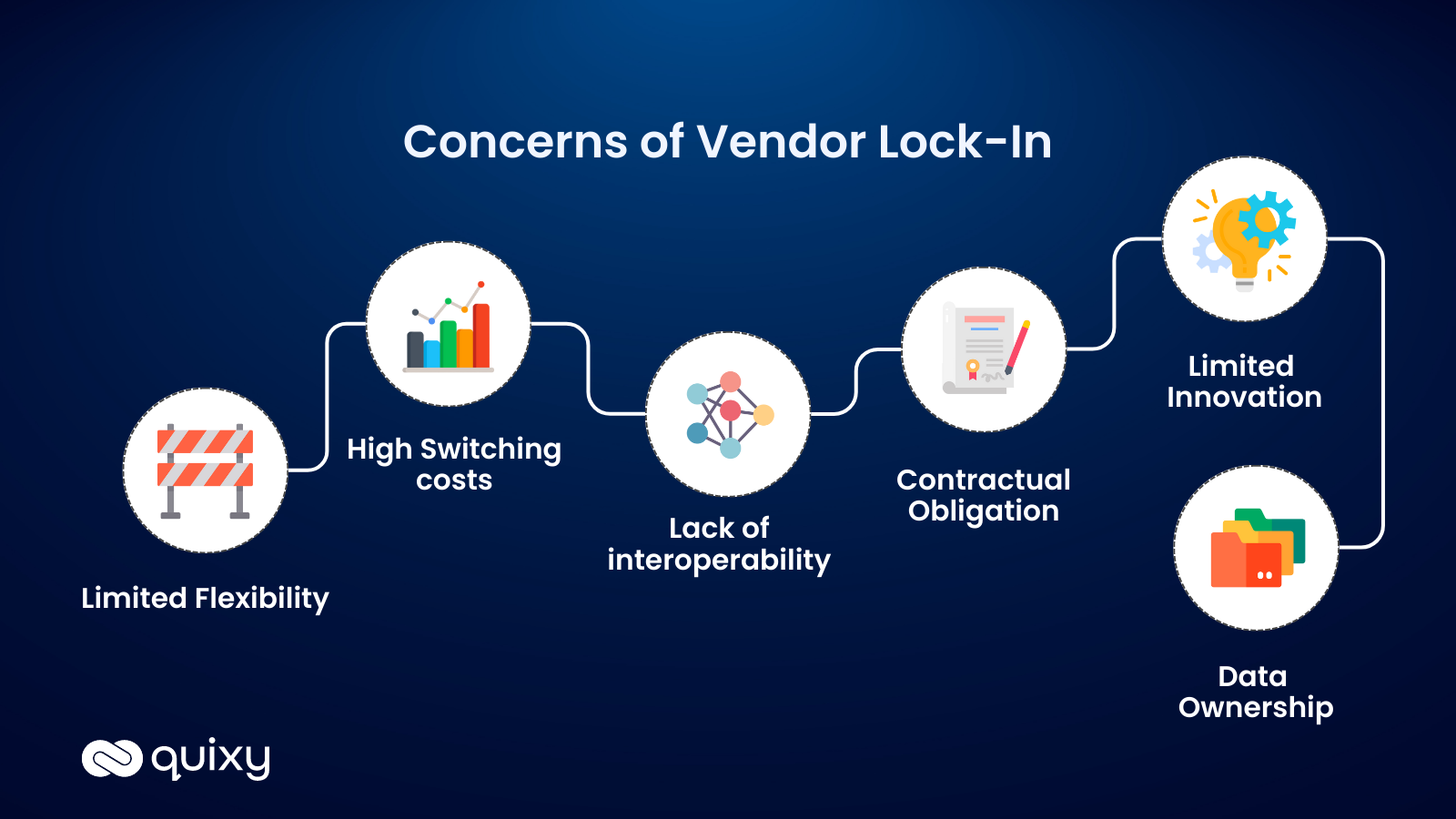
Organizations are interacting with customers and providers differently because of virtual technologies. Most IT services are controlled through cloud offerings. Many businesses pick cloud offerings for building and preserving their IT infrastructure. As maximum companies have been pressured to adopt the work-from-domestic version, cloud adoption has extended.
Cloud computing outsources software programs or computing infrastructure to cloud companies. It is feasible to grow to be “locked in” to a single cloud dealer when switching is just too expensive and time-consuming.
It’s easy to emerge as dependent on a seller’s software program once you contain it in your commercial enterprise and learn how to use it. In addition, shifting databases once they stay may be very tough, particularly in a cloud migration that may involve reformatting information. Early termination of contracts also can result in heavy economic consequences.
Vendor lock-in takes place while you can not pass your workloads between cloud carriers. Here are 10 methods to keep away from cloud dealer lock-in.
What is Vendor Lock-In?
It refers to a situation wherein clients are locked into a single product or service issuer without being capable of transfer without incurring extensive expenses. Several factors can also contribute to this, together with proprietary requirements, information format compatibility, and contract provisions.
Suppose a workplace has espresso introduced using an espresso seller, and this vendor best sells a selected type of coffee in the workplace. Consider what would show up if this vendor’s espresso declined steeply. The transfer to a new coffee vendor could require the purchase of a recent espresso-making device, so the antique machines might become useless. Considering the hassle and further cost of replacing each espresso gadget within an office, employees might be forced to drink inferior espresso if the antique seller is changed.
Apple’s lock-in to iTunes within the early days of the service, whilst songs bought through iTunes could best be performed on iPods or inside the iTunes application, is a real-global example of vendor lock-in.
What are the most critical Vendor lock-in concerns?

A vendor lock-in is a situation where a customer becomes dependent on a particular vendor for their products or services, making it difficult for them to switch to another vendor. This can be a problem for several reasons.
1. Limited flexibility
Vendor lock-in limits a customer’s flexibility as they’re restricted to a particular vendor’s offerings, which may not align with their evolving needs or business strategies.
2. High switching costs
Switching to a different vendor can be costly in terms of time and money, as customers may need to invest in new hardware or software, retrain employees, and migrate data to a new system.
3. Lack of interoperability
Vendor lock-in can lead to a lack of interoperability, making it difficult for customers to integrate their systems and data with other systems or switch to a different vendor.
4. Contractual obligations
Vendor lock-in can arise from contractual obligations that prevent customers from switching to a different vendor or limit their ability to do so. For example, a customer may be locked into a long-term contract that requires them to use a vendor’s products or services for a specified period.
5. Limited Innovation
Vendor lock-in can limit customers’ access to new and innovative products or services, as they may be less likely to explore new offerings from other vendors.
6. Data Ownership
Vendor lock-in can also lead to concerns over data ownership. When a customer is dependent on a vendor for their products or services, the vendor may have access to and control over the customer’s data. This can make it difficult for the customer to switch to a different vendor or to maintain control over their data.
Also Read: What is Decision Automation?
Challenges of Vendor Lock-In
1. Scalability Issues
A major concern about vendor lock-in is the lack of scalability. A corporation may also find it hard or even impossible to exchange to a unique supplier as soon as it has turned out to be locked into a selected seller. If a corporation’s business is developing or changing swiftly, this will pose a sizable hassle.
2. A Possibility of Price Increases
Businesses that depend on a single vendor for their products or services may also revel in charge increases in the future. This may present a specific venture for small groups, as they will not have the resources to analyze and examine opportunity solutions. Furthermore, businesses that are bound to a settlement with a vendor can not be able to negotiate a higher fee.
3. Unable to fulfill commercial enterprise objectives
Businesses cannot take advantage of improvements or features provided by competing vendors due to the fact they may be locked right into a single vendor. In this case, business desires can be unimaginable, and stagnation may result. An enterprise that makes use of a service or product from a single dealer might also have difficulty integrating comparable services and products from other vendors. The enterprise may be unable to undertake new technology or respond quickly to marketplace modifications as a result.
How is vendor lock-in in cloud computing different from Vendor lock-in in no-code low-code?
In cloud computing, vendor lock-in occurs when a customer becomes dependent on a particular cloud service provider for their infrastructure, platform, or software services. This can make switching to a different cloud service provider difficult due to the high switching costs, lack of interoperability, and contractual obligations. For example, a customer may have invested in a particular cloud service provider’s platform, and switching to a different provider may require significant retooling and retraining efforts.
In low-code no-code, vendor lock-in occurs when a customer becomes dependent on a particular vendor’s low-code no-code platform for developing applications or automating business processes. This can make switching to a different platform difficult due to the high switching costs, lack of interoperability, and limited flexibility. For example, a customer may have developed several applications using a particular vendor’s low-code no-code platform, and switching to a different platform may require significant retooling and retraining efforts.
However, vendor lock-in in low-code no-code can be different from cloud computing in terms of data ownership and innovation. In low-code, no-code, customers may have more control over their data as they are the ones developing the applications. Additionally, low-code no-code platforms may offer more opportunities for innovation as they allow customers to develop custom applications quickly and efficiently. However, customers should still be aware of the potential risks of vendor lock-in and take steps to mitigate them.
Also Read: 15 Questions CIOs Must Ask Low-Code No-Code Vendors
Tips for Avoiding Vendor Lock-In
By following those exceptional practices, you may reduce the threat of vendor lock-in:
1. Stakeholder Engagement
Understanding the particular risks related to cloud dealer lock-in calls for stakeholder engagement. The architects must provoke the dialogue regarding the benefits and disadvantages of cloud computing to the business enterprise. It is vital to involve all stakeholders in those discussions.
In making technical choices, architects and technical groups need to remember the commercial enterprise implications. Business necessities and dangers should be taken into consideration whilst designing an answer, such as packages, workloads, and structure. Consider the lock-in worries precisely for the vendor and the contractual responsibilities before migrating to a cloud carrier.
2. Analyze complicated dependencies
Examine your contemporary generation stack intently. The preference for cloud structures and infrastructure will possibly be restrained in case your IT workloads are designed to run on legacy technology.
3. Consider upgrading before migration
You may also want to don’t forget to upgrade your applications earlier than migrating to a cloud environment in case your packages are the simplest and like-minded with a restricted wide variety of cloud technology. There is a greater threat of destiny cloud vendor lock-in if your packages and workloads are most effective and well-matched with legacy technology supported via a few companies.
Any destiny requirement to trade carriers may incur a high cost or technical trouble as soon as one has been signed up with this type of provider.

4. Negotiate Your Exit Strategy
You need to continually bear in mind growing a go-out approach before signing an initial carrier agreement with your chosen cloud provider to avoid cloud vendor lock-in.
You should start asking the difficult questions while you reach the factor in the sales manner in which you’re discussing implementation info, which includes:
- If we want to exchange providers, what must we do?
- How can you help us with the reconversion method if we determine to transport somewhere else?
- In what instances can the agreement be terminated? What is the required observation duration?
- Can the provider settlement be mechanically renewed?
- While asking questions consisting of those can appear pessimistic, you’re truly preventing supplier lock-in before it becomes a difficulty.
- Don’t just ask; additionally, ensure that roles and responsibilities are virtually described in writing.
- If you decide to switch companies, be sure to apprehend what is required to terminate your agreement so you do not come across any unsightly surprises.
5. Consider hybrid or multi-cloud solutions
Hybrid and multi-cloud answers are getting increasingly famous dues to the fact they permit customers to choose upload-on offerings tailor-made specially to their business without having to commit to a single issuer. It is similar to the reason why people are leaving cable for streaming offerings. Why buy a package deal with channels you no longer require when you should purchase only the channels you require?
The benefit of a hybrid answer is its agility and reduced danger of lock-in. A hybrid cloud, however, can drastically grow the complexity of your structure, just as numerous streaming offerings can leave you channel-surfing between extraordinary systems.
6. Maintain a records governance framework
When agreeing with a supplier, you ought to make sure that you maintain management and possession over the records and insights approximately your commercial enterprise. Defending more sensitive facts, such as consumer facts, is viable by storing them in a private cloud or an on-premise records center.
Data governance can be maintained by deciding on a standardized format for storing facts and averting proprietary formats that could bring about supplier lock-in.
Migrating statistics from a single issuer to a brand-new provider may end up being more costly and time-consuming as your enterprise keeps shopping an increasing number of records with that provider.
One great way to preserve and manage over touchy historical facts is to use a cloud-based facts’ garage answer.
7. Backup your records
It is an incredible safety internet if you could return your information. If you’re unfortunate enough to be locked right into a vendor’s surroundings, you will be able to get admission to your backup records as a way to no longer has been altered. You may be substantially less dependent on your dealer if you have a backup.
8. Develop a multi-cloud approach
It is becoming increasingly popular to install applications across more than one cloud. Typically, a multi-cloud strategy involves the use of extra public cloud deployments from distinctive vendors while keeping the capability to allocate workloads among those deployments as needed.
By using this approach, companies cannot only keep away from seller lock-in but also take advantage of the quality pricing, functions, and infrastructure components to be had throughout cloud carriers. Data and packages must be sufficiently transportable across cloud systems and operating environments for a multi-cloud method to succeed.
9. Implement open standards and Make Apps Portable
As a result of this exercise, a variety of cloud options may be provided. Several cloud providers assist with maximum open requirements across a lot of industry verticals. With sufficient alternatives to be had, switching providers is simpler and extra effective.
To attain this, your IT workloads ought to be like-minded with non-proprietary alternatives. Vendor lock-in takes place whilst your workloads are tied to proprietary APIs, configurations, and capabilities. It can also turn out to be essential to carry out heavy customizations at a later stage if open requirements are not supported.
10. Develop and put into effect DevOps tools and methods
As a result of DevOps gear, code portability is increasingly being maximized.
It is viable to isolate software programs from their surroundings through the use of container technology furnished using companies that include Docker, which abstracts the dependencies far from the cloud company. If wanted, you have to be able to switch your application to a new cloud vendor considering most companies aid trendy container formats.
Additionally, configuration control equipment automates the procedure of configuring the infrastructure on which your packages run. As a result, your programs can be deployed to various environments, decreasing the difficulty of switching vendors.
Also Read: A Comprehensive Glossary of Digital Transformation Terms
Conclusion
Cloud adoption has been slowed down through seller lock-in. A multi-company cloud approach can mitigate vendor lock-in and decrease its impact on corporations. If a corporation is forced to move to a new issuer while not performing smooth facts migration from its contemporary issuer, having a backup of statistics can also mitigate vendor lock-in’s impact.
Frequently Asked Questions(FAQs)
Q. What is vendor lock-in?
Vendor lock-in is when a customer becomes dependent on a particular vendor’s products or services, making switching to an alternative vendor challenging or costly.
Q. What causes vendor lock-in?
Vendor lock-in can occur when a customer invests heavily in proprietary technologies, formats, or systems offered by a specific vendor, making migration or transition difficult without significant expense or disruption.
Q. What are the risks of vendor lock-in?
The primary risk of vendor lock-in is reduced flexibility and freedom for the customer. It can lead to increased costs, limited innovation, and reliance on a single vendor for critical services or products.
Q. How can I avoid vendor lock-in?
1. Choose standards-compliant tools: Pick solutions, including “no code” options, following industry standards for compatibility.
2. Select interoperable vendors: Opt for providers supporting data exchange among various systems, like “no code” tools, preventing vendor lock-in.
3. Secure flexible contracts: Negotiate agreements allowing scalability, modifications, and easy vendor changes, including for “no code” platforms like Quixy, without hefty penalties.
4. Stay updated on alternatives: Continuously assess new tools, including “no code” solutions and technological advancements to adapt when needed.
5. Prefer open-source or modular systems: Consider using open-source or modular tools, like “no code” platforms, for flexibility and reduced dependency on a single
Q. What should I consider before committing to a vendor?
1. Evaluate the vendor’s long-term roadmap and commitment to open standards.
2. Assess the ease of migration or transition to other vendors.
3. Understand the total cost of ownership, including potential exit costs.
4. Seek feedback from existing customers regarding their experiences with the vendor’s services and support.
5. Consider building in-house expertise to reduce dependency on external vendors.
Subscribe
Login
Please login to comment
0 Comments
Oldest
















